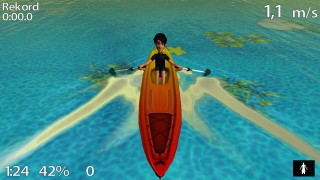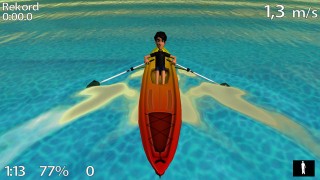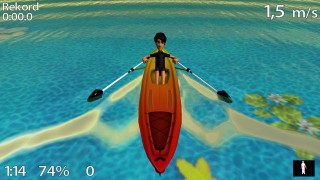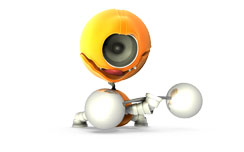
 |
 |
 |
BRIEF DESCRIPTION
The game Oarsman consists in establishing/breaking time records in river canoeing. The game simulates the behavior of a real kayak on the water. The desire of breaking a time record motivates the patient to compete with her-/himself as well as with other patients. The patient’s movements affect the velocity of the kayak and are reflected in the screen by the movements of the 3D virtual canoeist.
RECOMMENDATIONS AND POSSIBILITIES
The module designed for practicing the movements involved in the action of standing up, as well as for weight training. When performed with increased intensity, the exercise puts strain on muscles. The exercise can be set in one of the three modes: hand-movement (steering with hands), squat-movement (steering by performing squats), or standing-up mode (designed for patients in wheelchairs).
PATIENT REQUIREMENTS
The module does not require any special abilities. The 3 independent modes make the exercise very flexible with respect to the patient’s needs. When performing the exercise in the squat-movement mode, the patient can be suspended in the air (by, for instance, being tied to the cords hanging from the ceiling) or supported on the walker.
TASKS
The objective of the exercise is to travel a certain distance in the kayak. The user steers the kayak by performing some kind of regular movements, depending on the chosen mode. The patient can control the velocity of the kayak, but not its direction, as it moves only forward. The exercise should be performed several times. and patient’s scores should be compared to motivate her/him to break her/his own record.
In the hand-movement mode the patient has to move her/his hands symmetrically forward and backward. The range of these movements as well as their speed translates into the velocity of the kayak.
In the squat-movement mode the patient has to squat and get up. The depth and speed of performing the squats translates into the velocity of the kayak.
The standing-up mode is similar to the squat-movement mode. However, this mode is designed for the patients who cannot stand/squat on their own. The mode includes getting up in the wheelchair but allows the patient to support her-/himself by holding the wheelchair handle. This mode also requires less demanding movements.
DIFFICULTY LEVELS
The therapist can modify the level of the patient’s effort by changing the length of the distance, or by setting a certain ‘rowing difficulty’. This second modification can, for instance, make the kayak swim faster with less effort put into rowing. With such facilitations the game is accessible to the patients who are not capable of performing squats or move their arms with the full range of motion.
DATA AND REPORTS
The system saves data concerning the level of correctness and activity, as well as the depth and angular differences of the performed movements.
HINTS AND TIPS
The therapist can add a training note at any time during the training or after it. The note may be required, for instance, when the conditions of the exercise change, the patient’s comfort worsens during the exercise, or when the therapist simply wants to note the information that will be useful in further training. The note will be automatically updated with the date, hour and the therapist’s name, and visible as a record in the training journal.
More information


This is a modern approach to rehabilitation, which is fun for the patient. This form of a session, from the psychological point of view, brings many positive aspects, which result in stronger effects - desired in terms of improving the functioning of the people undergoing the rehabilitation. Find more Kinect Rehabilitation




